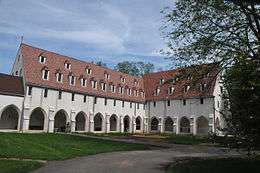Community of St John Baptist
The Community of St. John Baptist (CSJB), also known as the Sisters of Mercy, or formerly Clewer Sisters, is an Anglican religious order of Augustinian nuns.
History
The Community was founded in England in 1852 by Harriet Monsell (the first Superior), a clergy widow, and Thomas Thellusson Carter, a priest at Windsor. The purpose of the order was to help marginalised women – mainly single mothers, the homeless and sex trade workers – by providing them shelter and teaching them a trade. The work of the sisters expanded to include administering and working in orphanages, schools, convalescent hospitals, soup kitchens, and women's hostels.[1]
The Community is conspicuous amongst Anglican communities for its meteoric rise in numbers from the date of the foundation. By the time of Carter's death in 1901 there were some 300 Sisters. At its height, the Community had some 45 priories and branch houses.
CSJB in the United Kingdom
The community's headquarters were, historically, at their purpose-built Victorian convent in Hatch Lane, Windsor. This very large and imposing structure is a local landmark, and includes a highly decorated chapel, and extensive accommodation for sisters, guests, and the female destitute persons to whom the community traditionally gave shelter.[2] Following a sharp decrease in membership, the community found itself using only a tiny part of the buildings, and in 2001 relocated to Oxfordshire. The original convent has since been converted into flats.
The Sisters lived at Begbroke, near Kidlington in Oxfordshire for several years, then moved to their newly constructed Convent, Harriet Monsell House, on the campus of Anglican Theological College, Ripon College Cuddesdon in 2013. They also endowed a new chapel, Bishop Edward King Chapel, for the college which will be part of the Community's lasting legacy to the Church after it has completed its work. The Chapel has won several architectural awards since its completion.
Since 1996 the remaining sisters of another Order, the Community of the Companions of Jesus the Good Shepherd have been living with the SSJB sisters, and although the two Orders remain quite distinct, they share accommodation and many other aspects of community life.
CSJB in the United States

The Community expanded to the United States in 1874, following the donation of property by the family of the first American CSJB sister. Work was needed among German immigrants in New York's Lower East Side, and the community moved there. The American Mother House was eventually established at Mendham, New Jersey. Work in New York was ended in 1976. In 2007, however, the Sisters returned to Manhattan, opening a branch house at the Church of Saint Mary the Virgin (Times Square, New York).
The main convent at 82 West Main Street, Mendham, New Jersey, includes a retreat house for guests and also the community's historic church, all set in over 20 acres of land. The convent building was constructed as the Mother House of the American community in 1913. The sisters then closed down the Mother House at 233 E. 17th St. in Manhattan and moved permanently to Mendham in 1915. The Convent building was added to the American National Register of Historic Places (reference number 07000356) in 2007.[3] The architects of the main convent were Durr Friedley and William W. Cordingly. St. Marguerite's Retreat House in Mendham, Built in 1908 in the 'Tudor Revival' style, was a home and school for girls until after World War II, and is now a working retreat house for all denominations. Its architects were James Layng Mills and John C. Greenleaf.
CSJB in India
The Community no longer operates in the Indian sub-continent. Historically, however, there were CSJB houses and missions in India. Their story has been recorded by Valerie Bonham in a book entitled Sisters of the Raj: the Clewer Sisters in India.[4]
Character
Apart from ministries of social aid and assistance, members of the order live a life of prayer, and operate retreat facilities as well as providing retreats and spiritual direction. In these endeavours, they are guided by the Augustinian Rule's emphasis on community spirit.
References
- ↑ Anglican Religious Communities Yearbook: 2004–2005. Norwich: Canterbury Press, 2003.
- ↑ See this article about the site.
- ↑ National Park Service (2010-07-09). "National Register Information System". National Register of Historic Places. National Park Service.
- ↑ Book detailed here.
External links
- Website of the CSJB in England
- Website of the CSJB in the United States
- Biographical information on Mother Harriet Monsell CSJB, Founder of the Community of St John Baptist